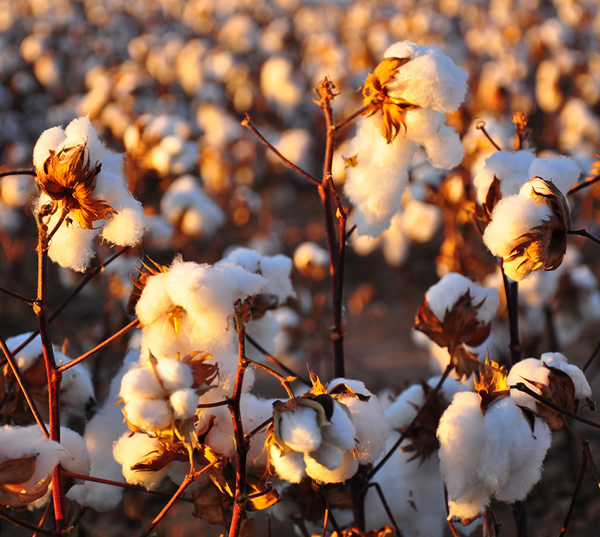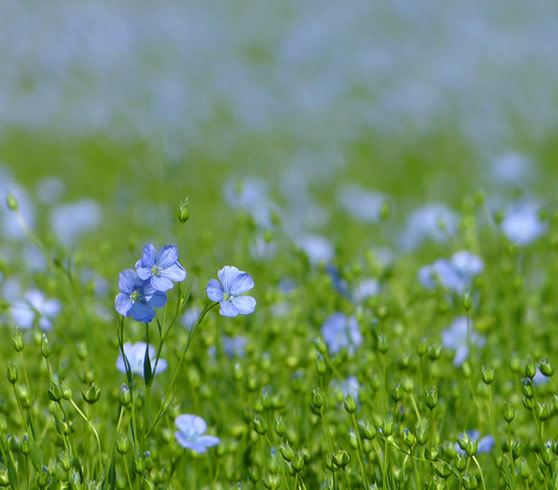 |
| Cotton plant |
Plants are the natural sources of many raw materials used to produce textiles, ropes, twine, and similar products.
The major fiber crops are cotton, flax, and hemp, although less important plants, such as ramie, jute, and sisal, are grown in small amounts. With a total annual production of more than 13 million tons, cotton is by far the most important fiber crop in the world. Because humans heavily rely on cotton for clothing and other textiles, it enters the daily lives of more people than any other product except salt.
Cotton
Cotton (Gossypium) fiber has been known and highly valued by people throughout the world for more than three thousand years. The early history of cotton is obscure. Avigorous cotton industry was present in India as early as 1500 b.c.e. From India, the cultivation of cotton spread to Egypt and then to Spain and Italy.
In the New World, a different species of cotton was being grown in the West Indies and South America long before Europeans arrived. In the United States, cotton is grown from the East Coast to the West Coast in the nineteen southern most states.
Botanically, cotton is in the mallow family, which also includes okra, hollyhock, hibiscus, and althea. Cotton has a taproot and branching stems. Flowers form at the tips of fruiting branches, and the ovary within each flower develops into a boll, which contains the seed, fiber, and fuzz. The fiber, most commonly referred to as lint, develops from epidermal cells in the seed coat of the cottonseed.
The fiber reaches its maximum length in twenty to twenty five days, and an additional twenty-five days are required for the fiber to thicken. Fiber length from 2.0 to 2.4 centimeters is referred to as short-staple cotton, and fiber length from 2.4 to 3.8 centimeters is called long-staple cotton.
The boll normally opens forty-five to sixty-five days after flowering. Cotton is native to tropical regions but has adapted to the humid, subtropical climate, where there are warm days (30 degrees Celsius), relatively warm nights, and a frost-free season of at least 200 to 210 days. There are eight species of cotton in the genus Gossypium, but only three species are of commercial importance.
Gossypium hirsutum, also known as upland cotton, has a variable staple length and is produced primarily in North and Central America. Gossypium barbadense, a long-staple cotton, is primarily produced in South America and Africa. Gossypium herbaceum is a shorter-staple cotton native to India and eastern Asia.
Cotton is one of the more labor-intensive and expensive crops to produce. The most opportune time to plant cotton is at least two weeks after the last killing-frost date of the region.
Prior to seeding, the field is prepared by plowing to a depth of 2.5 centimeters. Fertilizer, which is applied before seeding or at the same time the seeds are planted, is placed to the side and below the cotton seed.
Once the seeds germinate and emerge from the soil, they often have to be thinned, and shortly afterward the producer begins to apply irrigation water as needed. After the plants have developed a stand, weed control becomes crucial. Weeds are controlled both by cultivation and herbicides.
Cotton plants are subject to invasion by a variety of insect pests, such as the bollworm and bollweevil; therefore considerable attention is given to insect control, typically using a number of different insecticides.
When the bolls ripen with mature fiber, the leaves of the plant are removed by the application of a chemical defoliant, and the fiber is harvested. Harvesting was once done almost entirely by hand, but today mechanical pickers harvest almost all the cotton produced in the United States.
The picked cotton is ginned to remove the seed and compressed into bales. The bales are transported to a cotton mill, where the cotton is cleaned and spun into yarn, which is then woven into fabric. One pound of fiber is sufficient to produce up to 6 square yards of fabric.
Flax
 |
| Flax plants |
Flax (Linum usitatissimum) is the fiber used to make linen. While some flax is still grown for the purpose of producing this fabric, much of the flax, particularly that grown in the United States, is used to produce the flaxseed, from which linseed can be extracted. Linen made from flax is one of the oldest fabrics.
Flax was cultivated in Mesopotamia and Egypt five thousand years ago, and traces of flax plants have been identified in archaeological sites dating back to the Stone Age. Flax was one of the first crops brought to North America by European settlers. Today, most of the flax produced in the United States is grown in the north-central states.
An annual plant, flax grows to a height of 60 to 100 centimeters and bears five-celled bolls or capsules with ten seeds each at the ends of fertile branches. Because the flax fiber is found in the stems from the ground to the lowest branches, varieties that are long-stemmed with little branching are grown for fiber production. Selection of quality, disease-free seed is essential in flax production.
Flax fields are usually prepared in the fall to allow the soil to settle before planting. Flax is usually sown in early spring, two to three weeks prior to the date of the last killing frost of the region. Considerable attention is given to controlling weeds in a flax field.
When the crop is harvested for fiber, the plants are pulled from the soil, the seeds are removed, and the flax straw is “retted” to separate the fiber from the woody part of the stem. When the straw is completely retted, it is dried and then broken apart to remove the 50-centimeter fibers which can be woven into fabrics.
Hemp
Hemp (Cannabis sativa), a term used to identify both the plant and the fiber it produces, is used to make the strongest and most durable commercial fibers available. Hemp was most likely the first plant cultivated for its fiber.
It was cultivated for the purpose of making cloth in China as early as the twenty-eighth century b.c.e. It was also used as a drug by the ancient Persians as early as 1400 b.c.e. and was used as the cordage or rope on almost all ancient sailing vessels.
Today hemp is commercially produced for heavy textiles in numerous countries, but less than 1,000 acres is devoted to commercial hemp production in the United States. Hemp production is problematic in the United States because it is illegal to grow Cannabis sativa, the source of marijuana.
Hemp is an annual plant in the mulberry family. The plant is dioecious, meaning that it has staminate or “male” flowers and pistillate or “female” flowers. It has a rigid stalk, which can reach a thickness of more than 2.5 centimeters in diameter, and a height of 5 meters.
   |
The plant has a hollow stem, and the bark or “bast” located outside the woody shell is used to make the bast fiber, which is then used to make hemp twine, ropes, and other textiles where strength and durability are desired.
Humid climates with moderate temperatures and a period of at least 120 frost-free days are necessary for hemp production. Unlike flax, hemp requires that the soil be plowed and thoroughly disked or harrowed prior to planting. The entire above ground portion of the plant is harvested when the male plants are in full flower.
After two to three days the plants are tied in bundles and set in shocks. Hemp fiber is retted and prepared for the mills in a manner very similar to that of flax except that heavier machines are used to handle the stronger hemp stalks.
Minor Crops
Ramie (Boehmeria nivea) is produced primarily in Asia and is used to make strong cloth, such as Chinese linen. Jute (Corchorus capsularis) is grown primarily in India and Pakistan and is used to manufacture burlap for bags and sacks. Sisal (Agave sisalana) is produced in East Africa and the West Indies and is used to make different types of cordage, such as baler twine.
